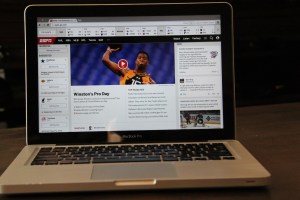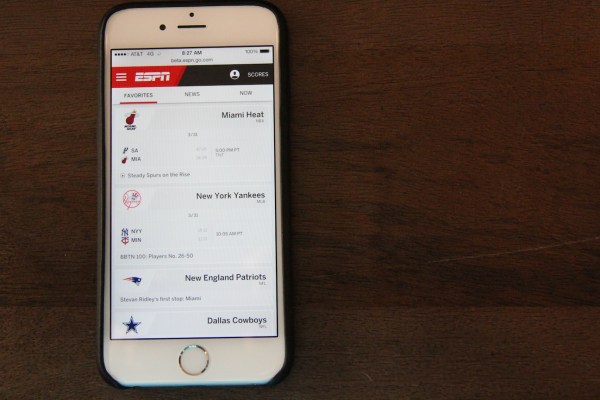Tomorrow, ESPN is launching a major redesign to an experience that has basically gone unchanged since its previous redesign in 2009.
The company has rebuilt its web experience: instead of having two different completely units — a mobile version and a desktop version — it’s now a single responsive unit that scales to the size of the device, using the same underlying technology.
“The whole world is different but [the website] is still highly resonant and fast-growing,” ESPN head of product Ryan Spoon said. “It’s important to us because it’s a new way for us to think about how we build and editorialize our products.”
Many web experiences are going through a similar change to be more responsive. This responsive design means that visual web experience will change based on the device. For ESPN, there’s three columns on the desktop version, but that shrinks down to a single one on mobile. The web version still has “tens of millions” of people using it every month, Spoon said.
ESPN’s strategy is to first present a sort of sort of unified experience across devices, hence the similarities between its new web version and its mobile applications. But the experience has to still “be honest to the environment with which it runs,” Spoon said.
Last week, The New York Times reported that several publishers are talking to Facebook about what content looks like natively on Facebook. In media circles, this is one of the hottest and most controversial subjects — what content looks like after the web as it was previously known is over. Does it look like a News Feed update, a story on Snapchat? All of these companies naturally have an incentive to bring content into the app experience: the longer users stick around, the more likely it is that they can be monetized in some fashion or, at the very least, have a better experience within the service and want to come back over and over.
 For ESPN, that’s already built into its development process. ESPN has already launched on Snapchat and last week launched on Facebook Messenger. Much of the experience is centered around content in the form of cards, which can be resized or delivered to multiple different platforms — hardware or software.
For ESPN, that’s already built into its development process. ESPN has already launched on Snapchat and last week launched on Facebook Messenger. Much of the experience is centered around content in the form of cards, which can be resized or delivered to multiple different platforms — hardware or software.
“Everything is one click to Facebook, Twitter, and those get flung to other environments,” he said. “Something special happens, we put it in [the Now column], and with one click and that sits as a Twitter card. That thinking is very influential for us as we went through the redesign process, and we also are inspired by the fact we do believe this can and should exist elsewhere.”
ESPN is one of Disney’s largest content brands and, if successful, could serve as a template for the rest of its activity across its properties.
In January, 61 percent of ESPN’s roughly 94 million users in the United States were viewing content exclusively on mobile devices, with a good chunk of that viewing content on its mobile web version. For a massive company like Disney trying to make a shift to mobile like any other content-driven company, a test of a new mobile web strategy for a large property like ESPN is critical.
First, ESPN has to convince its users that the change is a good idea, and with its massive audience that might be a harder sell than expected. But Spoon says, with 70 percent of the ESPN app’s users logged in, the benefits of adding more personalization and a more unified experience will outweigh the otherwise dramatic changes to the way its web presence feels. ESPN has also religiously tested the new user experience — a process that Spoon says drew him to ESPN in the first place.
